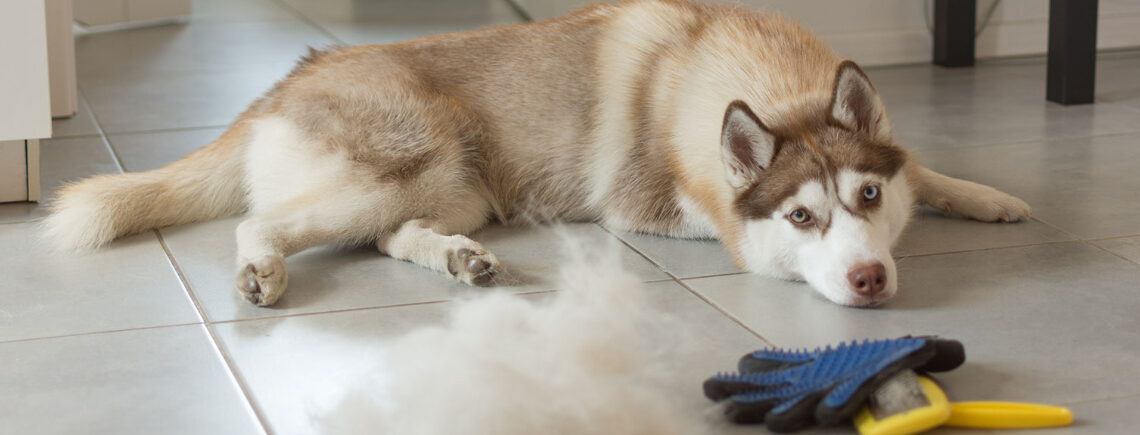Why Is My Dog Shedding?
Shedding is a natural process for dogs and an essential aspect of their skin and fur health. Dogs rid themselves of old, dead hair from their body through shedding. Depending on the breed of dog, the amount of fur that is shed can vary. For some dog breeds, like those with heavy double coats, shedding can be a nuisance, particularly during summer months when your dog’s hair loss can increase considerably.
In this blog post, we will look at managing your dog’s shedding to ensure their coat is kept nice and healthy!

Tara Murphy, Professional Groomer
Tara started working in Petmania in 2008 and has had many achievements along the way. She completed her City and Guilds Professional Dog Grooming exams and achieved a Diploma. Not too long after, she entered a IPDGA competition where she placed 4th in the Open Clipped Class. She is also a qualified Canine First Responder Instructor and delivers this class to groomers within Petmania. After working as a groomer for 7 years, she started the Petmania Grooming Academy in Petmania Kilkenny in 2015. Today she is an integral part of the Petmania Grooming Team.
What Causes Shedding?
All dogs shed, but some dogs, like those with a heavy double coat, can seem to shed excessively, which can be an inconvenience for some dog owners. Dog breeds such as a Jack Russel, Husky or Labrador can sometimes take shedding to the extreme, and it feels as though you forever have the vacuum out!
Some reasons for shedding are…
- Change in temperature, such as seasonal weather changes can cause your dog to shed those extra layers of warmth that have been keeping him snug throughout the winter
- Dry Skin – if your dog suffers with dry skin, it can cause the hair follicles to become clogged
- Irregular brushing – using a slicker brush daily on your dog’s coat will remove the dead hairs as they come loose, thereby helping to manage shedding
- An indoor dog with central heating at home

Can I Prevent Hair Loss?
Natural shedding is something which your dog needs to do in order to regulate his temperature, so there is no way to stop shedding completely. If you suffer from allergies, it’s best to bring home a dog that won’t shed as much, such as a maltese, bichon frise, schnauzer or poodle. Many prospective dog owners seek out dogs that are bred with these breeds, such as the poodle. However, there is no guarantee that a “doodle” mix won’t shed. It’s likely, though, that they won’t shed as much as most dogs.

How Do I Manage My Dog’s Shedding?
- Daily brushing of your dog’s coat is essential to remove loose, dead hairs
- A dull, dry coat and dry skin is often a sign of a poor diet, so changing your dog’s diet and including Omega Oils can support the skin
- A regular skin therapy like our DeShedding Therapy Bath will give the skin an intensive moisturizing treatment, loosening old dead hair and clearing the hair follicles to “lock” your dog’s coat in place for 6-8 weeks.
- Make sure your dog always has access to fresh water. It’s essential to their overall health, and it can also keep their skin hydrated. Dehydrated skin can exacerbate shedding and hair loss.
If you are struggling with managing your dog’s shedding, I would recommend a visit to your groomer, who can help you to get excessive hair loss under control, and help you find the right at home care routine, to make living with excessive canine confetti much easier!
Should I Be Worried About My Dog’s Hair Loss?
Shedding by itself isn’t generally something that should cause you concern, but if you don’t manage it correctly, the build-up of excessive dead hair in your dog’s coat can cause matting to occur. This can be very uncomfortable for your dog, as well as leading to other painful skin conditions.
Hair loss that reaches beyond your dog’s normal shedding can indicate health issues such as:
- Parasites like fleas, mites, or lice
- Bacterial infections
- Fungal infections
- Allergies
- Kidney disease
- Liver conditions
- Thyroid or adrenal issues
- Pregnancy
- Side-effects from medication
- Anxiety/stress/depression
- Cancer
- Immune disease
- Sunburn
- Topical irritants
Take your dog to the vet if you notice more hair loss than usual, inflamed skin, brittle fur, excessive scratching, or bald patches.
Shop Dog Grooming

Tara Murphy, Professional Groomer
Tara started working in Petmania in 2008 and has had many achievements along the way. She completed her City and Guilds Professional Dog Grooming exams and achieved a Diploma. Not too long after, she entered a IPDGA competition where she placed 4th in the Open Clipped Class. She is also a qualified Canine First Responder Instructor and delivers this class to groomers within Petmania. After working as a groomer for 7 years, she started the Petmania Grooming Academy in Petmania Kilkenny in 2015. Today she is an integral part of the Petmania Grooming Team.

